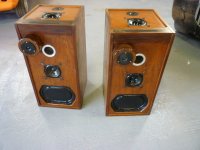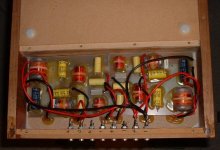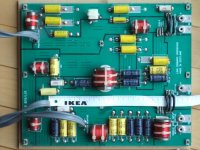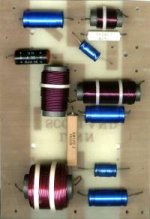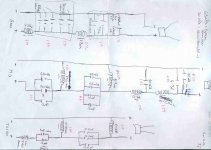hi,
I recently purchased a pair of Isobariks on eBay as part of a job-lot of audio gear. They had previously been bought at auction in Somerset area a few years ago and put into storage. The speakers have been professionally modified to put the front tweeter on its own mount. Can anyone shed any light on this? Is this a known isobaric tweak? Also, I would like to find a pair of isobarik stands if anyone has a pair spare. I have not listened to the speakers so don't know what difference the mod makes or whether they are fully functional.
I recently purchased a pair of Isobariks on eBay as part of a job-lot of audio gear. They had previously been bought at auction in Somerset area a few years ago and put into storage. The speakers have been professionally modified to put the front tweeter on its own mount. Can anyone shed any light on this? Is this a known isobaric tweak? Also, I would like to find a pair of isobarik stands if anyone has a pair spare. I have not listened to the speakers so don't know what difference the mod makes or whether they are fully functional.
Attachments
The seller didn't know anything about them as he bought them at auction. I said "professional" because someone has gone to a lot of trouble to modify them from original condition. The wooden tweeter mounts appear to have been specifically made and they are mounted on a flat metal ring, similar to the one used on the now-empty tweeter mounts. They may not be pretty but they are intriguing. I bought other items too which appear to be modified e.g a Rotel RP855 turntable with the internal ac PSU removed and replaced with a 12V DC plug for connection to an external wall-wart 12V PSU. The owner, whoever he is/was, clearly liked to tweak his audio gear to suit his musical taste. Its just possible that someone may recognise them or the mod and can give some more information about the reason for change.
Last edited:
This is very wrong. Return the tweeter back on the original place. Check if the original crossover was "professionally improved" too and restore the original condition.hi,
The speakers have been professionally modified to put the front tweeter on its own mount.
Last edited:
I am not familiar with Isobarik at all, only what I can find on internet. For all I know, these could have been modified by Linn themselves as part of speaker research and development, though that is unlikely and they would not normally be released to the public. Yes, I always have the option to restore to their original condition and the cabinets are in a pretty poor state anyway so will need some attention. They are notoriously difficult speakers to work on so it will be quite a challenge. The forum responses so far seem to have missed the point of my enquiry. I know they have been modified in an unusual way. I was trying to find out more about that before I do any major work on them.
They seem to be the original drive units, but...... Raising the tweeter mount as on the picture is a veery bad idea, unless the XO is seriously -and knowledgeably- modified, all you will get is a lot of phase, lobing, and dispersion problems. (mid to tweeter distance increased, driver acoustical radiating planes dislocated) In the original location of the tweeter, is that an empty hole, or what?
Last edited:
I believe the drivers are all original, not sure about the modified tweeters though. Its such a strange modification that I think someone had a good idea what they were doing and why they were doing it. Probably not clear from the picture, but the now-empty tweeter bay resembles a front-firing reflex port with a mesh grill though it has no tuning tube so more likely just for cosmetic appearance. I would be interested to find if the XO has been tweaked to match. With no link back to the original owner, its hard to guess what he was trying to do and for what reason.
Here, two pictures of the Isobarik XO-s (one old, the other a more recent one),
+ a part list of the (newer) crossover. I hope it can help you a bit....
(Schematic is unobtanium AFAIK).
+ a part list of the (newer) crossover. I hope it can help you a bit....
(Schematic is unobtanium AFAIK).
Attachments
So those are the Linn Isobarik ? Funny stuff, the things on the top !
They're basically two pairs of Kans, one vertical, the other horizontal, supplemented by isobarically loaded B139s. Something of an over-simplification, but in essence, that's the idea.
Scott - yes, rather simpler to describe than to build - I can remember drawings of these as a very complicated set of isolated sub -enclosures.
roclite - even now 41yrs after their original debut, the design format has merit - I can remember hearing both the passive XO and fully active version driven by a full six pack of Naim mono amps. While the enclosures do appear to be rather beat up, that wouldn't be as difficult to remedy as the hack job done on the unexplained relocation of front mounted tweeter. If all drivers are working, I'd definitely restore them to original configuration, and consider researching mods / upgrades to the passive XOs, including outboarding them.
roclite - even now 41yrs after their original debut, the design format has merit - I can remember hearing both the passive XO and fully active version driven by a full six pack of Naim mono amps. While the enclosures do appear to be rather beat up, that wouldn't be as difficult to remedy as the hack job done on the unexplained relocation of front mounted tweeter. If all drivers are working, I'd definitely restore them to original configuration, and consider researching mods / upgrades to the passive XOs, including outboarding them.
No way, nobody at Linn is that stupid to ruin perfectly good loudspeaker.For all I know, these could have been modified by Linn themselves as part of speaker research and development.
It is not an anusual way, it is a very wrong way - simply as that.The forum responses so far seem to have missed the point of my enquiry. I know they have been modified in an unusual way. I was trying to find out more about that before I do any major work on them.
You can't find anything rational in a very stupid modification.
No, they didn't have a clue.Its such a strange modification that I think someone had a good idea what they were doing and why they were doing it.
Oh no, it comes from bad to worse!Probably not clear from the picture, but the now-empty tweeter bay resembles a front-firing reflex port
I would have to agree: this is an appalling act of vandalism to a great speaker. It makes zero sense to modify these speakers in this way, for the reasons already given.
Maybe someone modelled the B139 drivers on some software and found a ported box solution and thought this might work. (They do model very well with a reflex cabinet) but I doubt that the un-modified box volume would work at all with the possible vent diameter offered by the original hole for the tweeter.
Maybe someone modelled the B139 drivers on some software and found a ported box solution and thought this might work. (They do model very well with a reflex cabinet) but I doubt that the un-modified box volume would work at all with the possible vent diameter offered by the original hole for the tweeter.
Thanks to jerryo and sonce for breaking the ice on condemning this idea - the "modifications" could best be described as a travesty
Simply put, the "isobarik" in name of the design describes a particular method for loading a pair of bass drivers (the B139s) in a specific way for very specific targeted performance. It's not commonly used as it not only doubles the cost of bass drivers, but also complicates construction - as anyone who's ever tried to replace the inner driver on a pair of Sara9s can attest.
If one of the targets of relocating the tweeter was to open the box up to "convert" to bass reflex mode of operation while still employing the dual 139s, the progenitor of that idea needs to go back to school, methinks.
That said, the enclosures may still be salvageable, and due to the rather rough condition of the enclosure shells, the remedial work required to restore them to close to their original condition could easily deal with that.
There are probably some bonafide tweaks or upgrades to the passive XO, either in terms of actual circuit topology, or at least parts replacement - after all this model was in production from 1973 to early 90's, and knowing Linn, there would have been numerous minor changes along the way, both announced and not.
Simply put, the "isobarik" in name of the design describes a particular method for loading a pair of bass drivers (the B139s) in a specific way for very specific targeted performance. It's not commonly used as it not only doubles the cost of bass drivers, but also complicates construction - as anyone who's ever tried to replace the inner driver on a pair of Sara9s can attest.
If one of the targets of relocating the tweeter was to open the box up to "convert" to bass reflex mode of operation while still employing the dual 139s, the progenitor of that idea needs to go back to school, methinks.
That said, the enclosures may still be salvageable, and due to the rather rough condition of the enclosure shells, the remedial work required to restore them to close to their original condition could easily deal with that.
There are probably some bonafide tweaks or upgrades to the passive XO, either in terms of actual circuit topology, or at least parts replacement - after all this model was in production from 1973 to early 90's, and knowing Linn, there would have been numerous minor changes along the way, both announced and not.
Thanks for all the useful comments and info on the unusual Isobariks. I should be able to restore back to their near original condition. Lets hope the "audiophile" who modified the speakers was restrained in a straight-jacket and locked up before he similarly tweaked the rest of his audio system 
- Home
- Loudspeakers
- Multi-Way
- Modified Linn Isobarik
